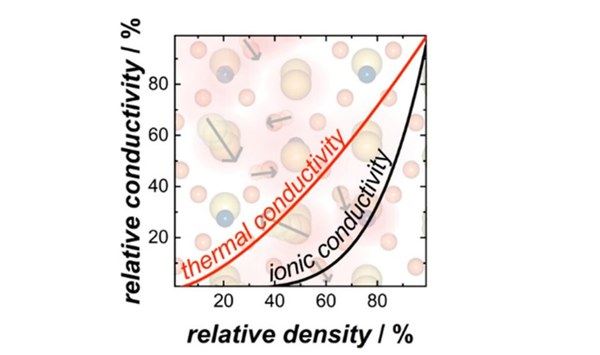Characterisation of Thermal Conductivity of Solid Electrolytes and Potential Challenges for Thermal Management in Battery Systems
Slow heat transport in Na3PS4 is based on the local exchange of heat between atomic vibrational states and places special demands on the thermal management of solid-state battery systems.

23 January 2023 – In their new study, researchers from Helmholtz Institute Münster (HI MS; IEK-12) of Forschungszentrum Jülich and the Institute of Inorganic and Analytical Chemistry of WWU Münster show how heat is transported in solid ionic conductors, which are being investigated for their potential application in solid-state batteries. The ability of the electrolyte material to dissipate heat is crucial for the thermal management of a solid-state battery.
Conductivity and Temperature Dependence of Na3PS4
Previous studies by Cheng and Bernges indicate that the thermal conductivity of ionic conductors is surprisingly low – regardless of whether silver, copper, sodium or lithium ions are transported. It is comparable to glasses and organic liquid electrolytes used in conventional battery systems.
Following on from these results, the team around Prof. Dr Wolfgang Zeier from Helmholtz Institute Münster and the Institute of Inorganic and Analytical Chemistry of WWU Münster now investigated the ion-conducting material Na3PS4 in a case study. "Our results show that the thermal conductivity of Na3PS4 is both glass-like and based on a fundamentally different mechanism of heat transport by atomic vibrations. The mechanism leads to slow heat transport and could also play a role in other ionic conductors," explains Tim Bernges from the Institute of Inorganic and Analytical Chemistry.
Furthermore, the researchers show that the thermal and ionic conductivities differ strongly in their scaling relationships to the relative sample density. "This should be taken into account when optimising transport in solid-state battery systems," says Bernges.
Requirements for Thermal Management of Solid-state Battery Systems
The low thermal conductivity of Na3PS4 in particular poses challenges for the thermal management of solid-state batteries. Although solid-state electrolytes are often considered particularly safe compared to conventional lithium-ion batteries with flammable liquid electrolyte, the low thermal conductivity entails slow heat dissipation. This can lead to an increase in device temperature – both on a global and local level. In the cathode composite, for example, this can lead to system failure.
This finding necessitates the characterisation of the thermal properties of all material components for solid-state batteries. It enables predictions about the heat flow in the system and the need for active and passive cooling solutions. In addition, the predictions and subsequent optimisation of heat transport must take into account the effects of relative density, since, as the study shows, ionic and thermal transport can differ significantly.
Study available in ACS Materials Letters
The detailed results of their study have been published by the researchers Tim Bernges, Thorben Böger, Oliver Maus, Paul S. Till and Dr Matthias T. Agne, Institute of Inorganic and Analytical Chemistry at WWU Münster, and Prof. Dr Wolfgang Zeier, Helmholtz Institute Münster (HI MS; IEK-12) of Forschungszentrum Jülich and the Institute of Inorganic and Analytical Chemistry at WWU, as an open access article in the journal ACS Materials Letters.
